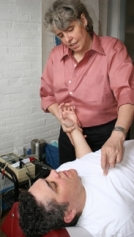When I’m meeting new people at a social or a networking event, I introduce myself as a Doctor of Chiropractic and an Applied Kinesiologist. Sometimes they have no idea what AK is and I fill them in. But most of the time, they will say something like “I had someone touch a spot on me and then pull down on my outstretched arm. It was weak. Then I held a bottle of pills and was told I needed them. Is that Applied Kinesiology?”
This is one of the big abuses of muscle testing.
In Applied Kinesiology, muscles are related to themselves and the joints they cross, their spinal innervation, their neuro-lymphathic & neuro-vascular points, the Chinese acupuncture meridian associated with them and the organs/glands via the meridian system.
So how does nutritional muscle testing work? First it is muscle specific, pulling down on an outstretched arm is not specific as it involves a number of muscles. And holding a bottle in hand stimulates nothing in your brain except maybe a placebo effect.
Here’s an example: a patient comes in with a shoulder problem and upon examination I find that one of the patient’s internal rotators – the Pectoralis Clavicular Major is weak.
The Pectoralis Clavicular is innervated by the lateral pectoral nerve that comes from the 5th & 6th cervical spinal nerves, it is associated w/ the Stomach meridian and in Chinese five-element theory is associated with worry.
Does the patient have a weak Pectoralis on one or do both sides tested together come up weak – a possible sign of cranial faults that need to be fixed? Does the patient have a history of digestive problems, heartburn, bloating, blenching, constipation? Is the patient experiencing emotional worries?
If no, then I proceed w/ either stretching or toning the muscle, rubbing out the neuro-lymphatic and neuro-vascular points for the muscles and seeing if the meridian is involved and seeing if the C5-6 spinal segments, the shoulder joints, clavicle or the sternum (breastbone ) or the ribs need to be adjusted. I then re-test the muscle to see if the problem is now fixed.

If yes, I proceed with the above as correcting the structural first sometime will help the digestive problems. A case in point is a patient with a lack of hydrochloric acid, indicated by bilateral pectoralis major weakness. Taking hydrochloric acid may clear the weakness.
But if the HCl is given, it hides the indicator for a temporal bulge or other cranial fault. A cranial fault may be causing entrapment of the Vagus nerve, thus causing hypochlorhydria that is responsible for the digestive problem in the first place. The proper approach is to correct the cranium and any other structural factor that is causing the hypochlorhydria.
I then talk to the patient about their diet, what foods or food combinations may be problematic for them and what supplements and medications – over the counter & prescription that they may be taking and to keep a food diary in which the patient also notes any digestive problems.
For example, the patient may have been advised to take Tums in order to get calcium; unfortunately the calcium carbonate in Tums is acting as an antacid and is adversely affecting the patient’s ability to digest and absorb food (including calcium) Take the patient off the Tums and the HCL problem resolves
I also talk to the patient about any emotional problems or stresses that may be affected them and we work w/ emotional meridian releasing techniques that the patient can also do at home.
On the next visit if the structural and emotional interactions have cleared then I test for nutritional factors such as HCL, or food allergies/sensitivities The patient is tested by placing sample of either the supplement or food in their mouth and having them chew in order to stimulate gustatory receptors in the brain and then the Pectoralis is then re-tested to see if there is a change in the muscle strength. The patient is then advised take whatever strengthened the indicator muscle and asked to note any changes in their food diary.
If nutritional testing doesn’t resolve the muscle weakness, then the patient may be advised to have some standard testing done such as testing for H. Pylori or anemia which can be affecting digestion such as iron, folic acid or B12 deficiencies.
On the following visit, the patient will continue to be evaluated to see if the digestive problems have resolved, if the structural and emotional indicators have resolved and when the patient no longer needs to take the supplementation.
As you see, the proper use of applied kinesiology in evaluating nutrition is made within the total framework of the triad of health – structural, emotional, chemical and includes both standard and kinesiologicial diagnostic procedures that confirm the need for the nutrition.
Correlation of applied kinesiology muscle testing findings with serum immunoglobulin levels for food allergies
© 2010-Dr. Vittoria Repetto
Want more information on Dr. Vittoria Repetto and her NYC Applied Kinesiology/Chiropractic/ NKT practice at 230 W 13th St., NYC 10011; please go to www.drvittoriarepetto.com
And please check out the Patient Testimonials page on my web site.
Want to be in the know on holistic information and postings?
https://www.facebook.com/wvillagechiropracticappliedkinesiologynkt/
Or join me at Twitter: www.twitter.com/DrVRepetto




